Arto's Blog
Pages: << 1 2 3 ...4 ...5 6 7 ...8 ...9 10 11 12 ... 27 >>
Camping up in the mountains between border controls
Posted: 2015-01-17 05:47:00, Categories: Travel, Cycling, Hiking, Chile, Argentina, 592 words (permalink)
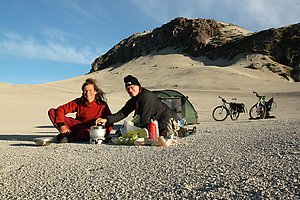 Our most spectacular campsite on this trip so far was near the Antonio
Samore mountain pass, right on the Argentinian-Chilean border. We set
up our tent on the plateau facing the Puyehue volcano with a panoramic
view of other volcanoes and mountains in every direction. The sunset
coloured the sky first orange and red, later violet, followed by a
clear full moon night.
Our most spectacular campsite on this trip so far was near the Antonio
Samore mountain pass, right on the Argentinian-Chilean border. We set
up our tent on the plateau facing the Puyehue volcano with a panoramic
view of other volcanoes and mountains in every direction. The sunset
coloured the sky first orange and red, later violet, followed by a
clear full moon night.
In Argentina we cycled the classic "seven lakes" route from San Martin de Los Andes until Villa la Angostura. It was a pretty road, but the weather was cloudy and rainy so we didn't spend much time at the lakes. In Villa la Angostura we stayed in a hostel and celebrated New Year with other travellers, mostly Argentinians on their holidays. On New Year's day we already headed back towards Chile.
 We camped one day at a river still on Argentinian side, and reached
the border at the top of the Antonio Samore pass on the second day.
The Argentinian customs and passport control had been already 20 km
before and the Chilean ones were 20 km further ahead. It seems to be
pretty common here that the border area is dozens of kilometers wide,
and it's not a problem to spend even several days between the control
points.
We camped one day at a river still on Argentinian side, and reached
the border at the top of the Antonio Samore pass on the second day.
The Argentinian customs and passport control had been already 20 km
before and the Chilean ones were 20 km further ahead. It seems to be
pretty common here that the border area is dozens of kilometers wide,
and it's not a problem to spend even several days between the control
points.
 Only a few hundred meters after the pass on the right hand side was
a small jeep track leading up towards the nearby peaks. We followed
that and were soon like in a different world: sand everywhere, small
streams in deep canyons and a view towards all directions. We could
see the Puyuhue and Casablanca volcanoes, various other mountains and
also Puntiagido and Osorno volcanoes further away.
Only a few hundred meters after the pass on the right hand side was
a small jeep track leading up towards the nearby peaks. We followed
that and were soon like in a different world: sand everywhere, small
streams in deep canyons and a view towards all directions. We could
see the Puyuhue and Casablanca volcanoes, various other mountains and
also Puntiagido and Osorno volcanoes further away.
After about a kilometer we left most of our bags on the side of the track and continued further up with a lighter load. Then we left the bikes behind as well and climbed on top of the nearest peak. In the loose sand we got our shoes full of sand and small stones, but otherwise it was quite easy to climb. On the top we had a picnic and enjoyed the sunny afternoon.
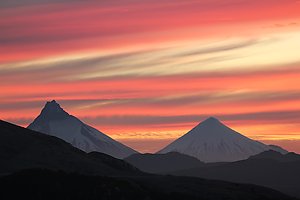 We descended on the north side and were directly on the border,
indicated by an old metal sign saying "Chile" on one side and
"Argentina" on the other. The track ended there but some footsteps
were going forwards. We followed them and climbed still the next,
slightly higher peak before coming back and picking up our stuff.
We descended on the north side and were directly on the border,
indicated by an old metal sign saying "Chile" on one side and
"Argentina" on the other. The track ended there but some footsteps
were going forwards. We followed them and climbed still the next,
slightly higher peak before coming back and picking up our stuff.
 It was surprisingly windstill so we chose to set up the tent
directly on the open plateau at 1500 meters of altitude. It was a rare
place, with so much sand around and looking very dry, but still having
water available in several small streams. We cooked dinner and
prepared tea while admiring the sunset. Then we had a rest in the
tent, but came later out for a while to watch the moon and the stars
before going to bed. The temperature dropped below zero during the
night, but our sleeping bags were warm enough to sleep comfortably.
It was surprisingly windstill so we chose to set up the tent
directly on the open plateau at 1500 meters of altitude. It was a rare
place, with so much sand around and looking very dry, but still having
water available in several small streams. We cooked dinner and
prepared tea while admiring the sunset. Then we had a rest in the
tent, but came later out for a while to watch the moon and the stars
before going to bed. The temperature dropped below zero during the
night, but our sleeping bags were warm enough to sleep comfortably.
In the morning we had breakfast, packed our things, cycled back to the main road and further down to the valley towards Entre Lagos and Osorno. On the good paved road it was a fast ride through a quite strange landscape of dead trees. Later a park ranger explained us that it was a result of an eruption at one of the Puyuhue volcano side craters just a few years ago. The grey scenery lasted for about 10 kilometers, down in the valley everything was green again.
Hot springs and strawberries for Christmas
Posted: 2014-12-29 16:13:00, Categories: Travel, Cycling, Chile, Argentina, 930 words (permalink)
 This year we spent an alternative Christmas by camping and visiting
thermal baths along a small road crossing the Andes between Coñaripe,
Chile and San Martin de Los Andes, Argentina. In the morning of
Christmas eve we were the last time within the reach of mobile
networks and sent some "Merry Christmas" messages to our family and
friends, before being unreachable for several days.
This year we spent an alternative Christmas by camping and visiting
thermal baths along a small road crossing the Andes between Coñaripe,
Chile and San Martin de Los Andes, Argentina. In the morning of
Christmas eve we were the last time within the reach of mobile
networks and sent some "Merry Christmas" messages to our family and
friends, before being unreachable for several days.
 On December 23rd we cycled from Coñaripe on the shore of Lake
Calafquén further south-east to Liquiñe, the last village
before the climb up to the Carririñe mountain pass and the
Chilean-Argentinian border. There were several thermal baths in the
village and nearby. We followed the suggestion of the tourist info and
chose a modest one called Termas Trafipan where it was also possible
to camp. It had one bigger pool with warm water, perhaps around 35
degrees, and a separate building with small private rooms, each
containing a bath tub. Nothing fancy, but a good place to wash out the
dust of the road.
On December 23rd we cycled from Coñaripe on the shore of Lake
Calafquén further south-east to Liquiñe, the last village
before the climb up to the Carririñe mountain pass and the
Chilean-Argentinian border. There were several thermal baths in the
village and nearby. We followed the suggestion of the tourist info and
chose a modest one called Termas Trafipan where it was also possible
to camp. It had one bigger pool with warm water, perhaps around 35
degrees, and a separate building with small private rooms, each
containing a bath tub. Nothing fancy, but a good place to wash out the
dust of the road.
Being used to Europe it was a little funny to have Christmas in the summer, in the middle of strawberry and raspberry season. The shops in Liquiñe didn't have a very large selection of fruits, but we did find strawberries in one of them. Knowing that it would be the last chance of shopping before over 100 km of slow mountain roads, we also bought some apples and bananas before heading forwards. A sufficient stock of rice, pasta and other dry foods we had already acquired a couple of days earlier.
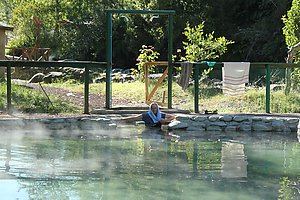 After 10 km of up and downhills we came to Termas Hipolito Muñoz.
After a short look around it was clear that we'd stop there for the
rest of the Christmas eve. It had an idyllic setting in the river
valley, plenty of trees to provide shade from the afternoon sun and
good, clean sanitary facilities. For bathing, there was one warm pool
and another hot one with clearly over 40 degrees, plus showers and the
river providing for cold water. All of them were outside, open day and
night so it was possible to take a bath under the stars too. It was
peaceful and quiet, simply a wonderful place. There was
also a small rustic steam sauna, which looked interesting but the
smell of sulfur was so strong that we came out after a few seconds.
After 10 km of up and downhills we came to Termas Hipolito Muñoz.
After a short look around it was clear that we'd stop there for the
rest of the Christmas eve. It had an idyllic setting in the river
valley, plenty of trees to provide shade from the afternoon sun and
good, clean sanitary facilities. For bathing, there was one warm pool
and another hot one with clearly over 40 degrees, plus showers and the
river providing for cold water. All of them were outside, open day and
night so it was possible to take a bath under the stars too. It was
peaceful and quiet, simply a wonderful place. There was
also a small rustic steam sauna, which looked interesting but the
smell of sulfur was so strong that we came out after a few seconds.
There would have been cabins to rent but the weather was constantly sunny so we didn't see any need for one and set up our tent. We were the only ones camping, in addition to us there were just one family in a cabin and a couple of day guests who didn't stay overnight. We spent a relaxed afternoon in and outside the pools before preparing dinner. It consisted of spaghetti with tomato sauce, followed by tea, strawberries and a selection of cookies for dessert. We invited a Chilean couple to share the cookies with us and they brought us orange juice and avocadoes, which we had for breakfast next morning. After the sunset we had a night bath before going to sleep.
 We thought of staying a second day but decided to continue towards
the border on the following day. The road became smaller and smaller
but at the same time easier to cycle, because the surface was smoother
than on most gravel roads which are covered with a layer of small
stones. Traffic was non-existant, so we also didn't have any dust to
worry about. In the afternoon we reached the Chilean border post, which
was manned but closed. The suprised border guards had a short
negotiation between them about whether we could stay at the border,
but decided to send us away. We pedaled about a kilometer back, camped
in the forest out of sight of the guards and came back the next
morning.
We thought of staying a second day but decided to continue towards
the border on the following day. The road became smaller and smaller
but at the same time easier to cycle, because the surface was smoother
than on most gravel roads which are covered with a layer of small
stones. Traffic was non-existant, so we also didn't have any dust to
worry about. In the afternoon we reached the Chilean border post, which
was manned but closed. The suprised border guards had a short
negotiation between them about whether we could stay at the border,
but decided to send us away. We pedaled about a kilometer back, camped
in the forest out of sight of the guards and came back the next
morning.
This time we had better luck, there had been a change of shift and the new guards were ready to open the border. We were apparently the first ones wanting to cross, as it took a bit of time before they started their computer, examined our documents, took a photo of us with a mobile phone (!), and adjusted the right date in the stamp after first stamping our passports with completely wrong date. All of that was carried out in a very friendly manner and then we were off towards Argentina.
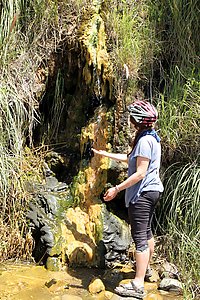 The last three kilometers before the highest point of the pass were
very steep and we had to push our bikes at least half of the way.
After that it was almost as steep downhill on the Argentinian side,
descending to the Lanin National Park. There we had one more visit to
thermal pools, this time free ones next to a trail in the park.
However, those pools had more murky water and were in general less
attractive so we didn't spend too much time there.
The last three kilometers before the highest point of the pass were
very steep and we had to push our bikes at least half of the way.
After that it was almost as steep downhill on the Argentinian side,
descending to the Lanin National Park. There we had one more visit to
thermal pools, this time free ones next to a trail in the park.
However, those pools had more murky water and were in general less
attractive so we didn't spend too much time there.
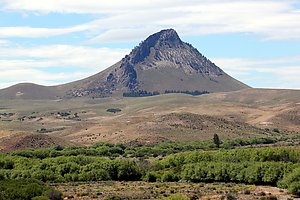 It took us two days to cycle through the park. It had less trails and
facilities than the parks we had been visiting in Chile, but a similar
mix of forest, lakes, rivers and mountains. When moving more east the
terrain became slowly more and more dry, opening a whole new type of
scenery in front of us. Eventually we also reached the Argentinian
border control post, which was more than 50 km away from the actual
border. Again stamps in the passports and we were officially in a new
country. One more day of cycling brought us to San Martin de Los
Andes, the biggest town of the region with about 24000 inhabitants.
It took us two days to cycle through the park. It had less trails and
facilities than the parks we had been visiting in Chile, but a similar
mix of forest, lakes, rivers and mountains. When moving more east the
terrain became slowly more and more dry, opening a whole new type of
scenery in front of us. Eventually we also reached the Argentinian
border control post, which was more than 50 km away from the actual
border. Again stamps in the passports and we were officially in a new
country. One more day of cycling brought us to San Martin de Los
Andes, the biggest town of the region with about 24000 inhabitants.
Volcanic scenery in Malalcahuello and Conguillio
Posted: 2014-12-29 16:06:00, Categories: Travel, Cycling, Hiking, Chile, 823 words (permalink)
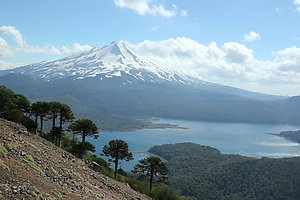 We spent 1,5 weeks exploring the Malalcahuello National Reserve and
the Conguillio National Park, both on foot and by bicycle. Both parks
were dominated by volcanoes and their past activity, including several
eruptions during the last 100 years. The contrast between almost black
volcanic sand and lush green forests was dramatic. There were a lot of
magnificent hundreds of years old trees, with thick layers of
lichen growing on the trunks and hanging from the branches.
We spent 1,5 weeks exploring the Malalcahuello National Reserve and
the Conguillio National Park, both on foot and by bicycle. Both parks
were dominated by volcanoes and their past activity, including several
eruptions during the last 100 years. The contrast between almost black
volcanic sand and lush green forests was dramatic. There were a lot of
magnificent hundreds of years old trees, with thick layers of
lichen growing on the trunks and hanging from the branches.
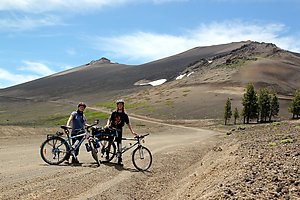 We started by cycling from Victoria to Curacautin and further to
Malalcahuello where we stayed with Claudia from CouchSurfing. She had
a beautiful house a few km outside the village, so deep in a valley
between the mountains that we didn't even have mobile phone
reception there. It was a good place for relaxing and an excellent
base for tours in the region.
We started by cycling from Victoria to Curacautin and further to
Malalcahuello where we stayed with Claudia from CouchSurfing. She had
a beautiful house a few km outside the village, so deep in a valley
between the mountains that we didn't even have mobile phone
reception there. It was a good place for relaxing and an excellent
base for tours in the region.
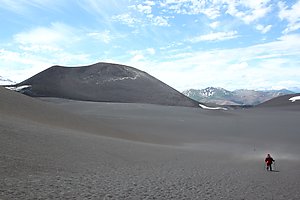 On one day we cycled up along the road leading to a ski center at the
Lonquimay volcano, the highest peak of the area. There was still quite
a bit of snow covering the higher parts of the volcano, but not enough
for skiing so it was off-season and quiet. From the ski center started
a still smaller road, marked as being for 4x4 vehicles only but it was
also suitable for bicycles.
On one day we cycled up along the road leading to a ski center at the
Lonquimay volcano, the highest peak of the area. There was still quite
a bit of snow covering the higher parts of the volcano, but not enough
for skiing so it was off-season and quiet. From the ski center started
a still smaller road, marked as being for 4x4 vehicles only but it was
also suitable for bicycles.
 The road led us across dark volcanic sand to a sign which marked
the start of a walking trail to Crater Navidad, the crater of the last
eruption of the volcano on Christmas day 1988. After a 1,5 hour walk
through the dusty sand field and a slope of loose stones we stood at
the edge of the crater, at 1891 meters of altitude. It was almost 1000
meters lower than the main volcano but had a panoramic view over the
lava flow and the surrounding area. The rocks at the crater had
many different colours, a lot of varioud shades of red, some white,
brown and yellow in addition to the dominatic nearly black rocks.
The road led us across dark volcanic sand to a sign which marked
the start of a walking trail to Crater Navidad, the crater of the last
eruption of the volcano on Christmas day 1988. After a 1,5 hour walk
through the dusty sand field and a slope of loose stones we stood at
the edge of the crater, at 1891 meters of altitude. It was almost 1000
meters lower than the main volcano but had a panoramic view over the
lava flow and the surrounding area. The rocks at the crater had
many different colours, a lot of varioud shades of red, some white,
brown and yellow in addition to the dominatic nearly black rocks.
 On another day we walked the Piedra Santa trail which started down in
the village and went through a forest on top of a hill. There were a
lot of old trees with lichen hanging from every small
branch, creating a quite special atmosphere. In higher altitudes,
other tree types gave way to the Araucarias, our favourite tree
because of their beautiful shapes against the blue sky. Because of the
approaching holidays we called them the Christmas trees of Chile. We
also saw a pair of condors cruising in the air. Otherwise there were
surprisinly few birds to see or hear, we thought that in such an old
forest we'd be hearing birds singing almost all the time.
On another day we walked the Piedra Santa trail which started down in
the village and went through a forest on top of a hill. There were a
lot of old trees with lichen hanging from every small
branch, creating a quite special atmosphere. In higher altitudes,
other tree types gave way to the Araucarias, our favourite tree
because of their beautiful shapes against the blue sky. Because of the
approaching holidays we called them the Christmas trees of Chile. We
also saw a pair of condors cruising in the air. Otherwise there were
surprisinly few birds to see or hear, we thought that in such an old
forest we'd be hearing birds singing almost all the time.
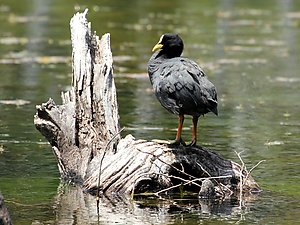 From Malalcahuello we returned to Curacautin and continued south
through the Conguillio National Park. It had also black volcanic
scenery like the Malalcahuello Reserve, but more lakes and also
non-volcanic peaks of more than 2000 meters. The main road through the park was a narrow
gravel and earth road, allowed for all kinds of vehicles but some
parts would have been fairly difficult to manage with a normal car. No
wonder that the most common vehicles in the Chilean countryside are
4-wheel-drive pickups, jeeps and SUVs. There it at least makes sense
to have one, unlike in most places in Europe and North America where
even minor roads are so good that a normal car is not only more fuel
efficient but also better to drive.
From Malalcahuello we returned to Curacautin and continued south
through the Conguillio National Park. It had also black volcanic
scenery like the Malalcahuello Reserve, but more lakes and also
non-volcanic peaks of more than 2000 meters. The main road through the park was a narrow
gravel and earth road, allowed for all kinds of vehicles but some
parts would have been fairly difficult to manage with a normal car. No
wonder that the most common vehicles in the Chilean countryside are
4-wheel-drive pickups, jeeps and SUVs. There it at least makes sense
to have one, unlike in most places in Europe and North America where
even minor roads are so good that a normal car is not only more fuel
efficient but also better to drive.
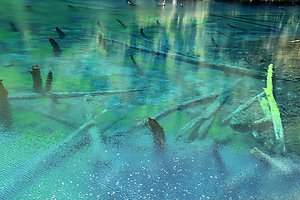 The highlights of Conguillio were the lakes, each of which had a
different character. Laguna Captrén had sunken trees sticking
out of the water and several bays with more bird life than we saw in
other areas of the park. The Conguillio lake was the biggest lake with
a panoramic view of the mountain range behind it, and an interesting
mix of volcanic rocks and plants on the shore. But perhaps the most
beautiful was the tiny Laguna Arco Iris, which was surrounded from one
side by a lava field and from the other side by forest, and had
wonderful colours in the water when looking down from the shore.
The highlights of Conguillio were the lakes, each of which had a
different character. Laguna Captrén had sunken trees sticking
out of the water and several bays with more bird life than we saw in
other areas of the park. The Conguillio lake was the biggest lake with
a panoramic view of the mountain range behind it, and an interesting
mix of volcanic rocks and plants on the shore. But perhaps the most
beautiful was the tiny Laguna Arco Iris, which was surrounded from one
side by a lava field and from the other side by forest, and had
wonderful colours in the water when looking down from the shore.
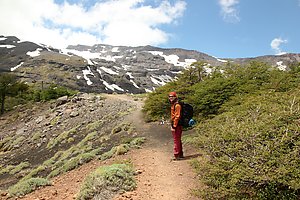 We also did a one day hike on the Sierra Nevada trail, which went up
from the Conguillio lake to the non-volcanic peaks. We didn't climb
until the top but above treeline and had very varying scenery on the
way. From a distance the mountains looked a lot like the Alps in
Europe, but both the trees and other vegetation were quite
different.
We also did a one day hike on the Sierra Nevada trail, which went up
from the Conguillio lake to the non-volcanic peaks. We didn't climb
until the top but above treeline and had very varying scenery on the
way. From a distance the mountains looked a lot like the Alps in
Europe, but both the trees and other vegetation were quite
different.
Overall, we were surprised how few people we met on the trails. They were easy to walk and well marked, but it seemed that most of the visitors just drove through the park by car, perhaps stopping at a couple of sightseeing spots. We think that by doing so we'd be missing a lot — even by going slowly on a bicycle it's not possible to reach areas away from the roads and see the nature in the same detail than on the walking trails.
Cycling and camping in Chilean summer
Posted: 2014-12-13 14:52:00, Categories: Travel, Cycling, Chile, 931 words (permalink)
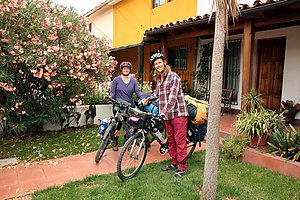 Our honeymoon trip has begun. We are currently in Curacautin in Chile,
about 600 km south of Santiago and will continue towards the south. We
plan to travel mainly by bicycle and take a bus or ferry for some
parts of the way to reach Ushuaia, Argentina by the end of
February. Here on the southern hemisphere it's the beginning of
summer, with daily maximum temperatures between 20 and 30 °C and
nightly minimum around 10 °C. It will get colder towards the south, but
should still be good weather for camping and outdoor life.
Our honeymoon trip has begun. We are currently in Curacautin in Chile,
about 600 km south of Santiago and will continue towards the south. We
plan to travel mainly by bicycle and take a bus or ferry for some
parts of the way to reach Ushuaia, Argentina by the end of
February. Here on the southern hemisphere it's the beginning of
summer, with daily maximum temperatures between 20 and 30 °C and
nightly minimum around 10 °C. It will get colder towards the south, but
should still be good weather for camping and outdoor life.
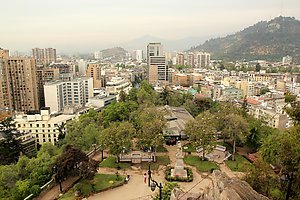 We packed our bicycles and other gear in two carton boxes and two
backpacks and flew to Santiago, where we had the pleasure of staying
with the family of Elba, our Spanish teacher in Germany. That was a
great introduction to Chilean culture and a full time Spanish course
for a week, with different family members coming by and talking with
us. In addition to seeing around in the city and spending time with
the family we took care of various practical things such as changing
money, getting Chilean SIM cards for our phones and reassembling our
bicycles. We also did a 1,5 day bus trip to Valparaiso, a seaside city
with old colourful houses on hills.
We packed our bicycles and other gear in two carton boxes and two
backpacks and flew to Santiago, where we had the pleasure of staying
with the family of Elba, our Spanish teacher in Germany. That was a
great introduction to Chilean culture and a full time Spanish course
for a week, with different family members coming by and talking with
us. In addition to seeing around in the city and spending time with
the family we took care of various practical things such as changing
money, getting Chilean SIM cards for our phones and reassembling our
bicycles. We also did a 1,5 day bus trip to Valparaiso, a seaside city
with old colourful houses on hills.
 From Santiago we took a bus 400 km south to Chillan, a city of about
160 000 inhabitants in the Bio-Bio region. It was already much more
relaxed than the metropolitan region and our Couchsurfing host Camila
took us to a trip to the nature near the mountains. We walked to an
idyllic spot by the Diguillin river, went swimming in the crystal
clear water and had a picnic on the riverside rocks enjoying the
sun. There was also a beautiful waterfall with a possibility to go in
a small cave behind the falling water.
From Santiago we took a bus 400 km south to Chillan, a city of about
160 000 inhabitants in the Bio-Bio region. It was already much more
relaxed than the metropolitan region and our Couchsurfing host Camila
took us to a trip to the nature near the mountains. We walked to an
idyllic spot by the Diguillin river, went swimming in the crystal
clear water and had a picnic on the riverside rocks enjoying the
sun. There was also a beautiful waterfall with a possibility to go in
a small cave behind the falling water.
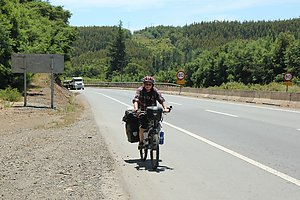 From Chillan we started our cycling tour, first following the
Pan-American Highway (Panamericana). It is the main route going
across the whole North, Central and South America. It was noisy and
not the nicest road to cycle on, but quite safe because of the large
shoulders and not as bad for the amount of traffic as most highways in
Germany. In some places it was also possible to ride on a smaller
service road next to the main highway.
From Chillan we started our cycling tour, first following the
Pan-American Highway (Panamericana). It is the main route going
across the whole North, Central and South America. It was noisy and
not the nicest road to cycle on, but quite safe because of the large
shoulders and not as bad for the amount of traffic as most highways in
Germany. In some places it was also possible to ride on a smaller
service road next to the main highway.
About 80 km further south we stopped to see Saltos de Laja, well known waterfalls near the Panamericana. The walkway to the falls was lined with snack and souvenir shops, but the waterfalls themselves and the river were in a natural state, not spoiled with fences or other constructions. A great view and a refreshing shower of millions of tiny waterdrops carried by the wind from the falls.
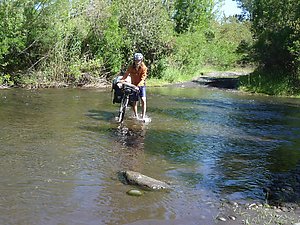 After Saltos de Laja we chose an alternative route and got our first
taste of gravel roads in Chile. First it was quite good to cycle but
soon turned into fairly rough and narrow road. At one point we even
had to cross a 10 meters wide and 20 cm deep river. One house had a
sign saying cheese for sale — we bought some homemade fresh
cheese and got a big bag of cherries from the garden as a present. It
took us more than 3 hours to cycle the 20 km gravel section, but
traffic was minimal and the scenery beautiful so it wasn't too bad.
The last 10 km were nice, paved, quiet road and after that we joined
the Panamericana again for two days.
After Saltos de Laja we chose an alternative route and got our first
taste of gravel roads in Chile. First it was quite good to cycle but
soon turned into fairly rough and narrow road. At one point we even
had to cross a 10 meters wide and 20 cm deep river. One house had a
sign saying cheese for sale — we bought some homemade fresh
cheese and got a big bag of cherries from the garden as a present. It
took us more than 3 hours to cycle the 20 km gravel section, but
traffic was minimal and the scenery beautiful so it wasn't too bad.
The last 10 km were nice, paved, quiet road and after that we joined
the Panamericana again for two days.
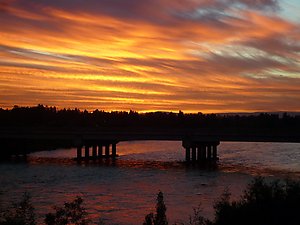 During the 240 km between the cities of Chillan and Victoria we
camped four nights, every time next to a river. One of them was a
campsite with facilities, in all other cases we just looked for a
place ourselves or asked the locals where to pitch the tent. Sometimes
it took a bit of time to find a suitable spot, as fields and
forests tend to be surrounded by fences, but mostly it was quite
easy. The rivers were clean and good to swim in, for cooking and
drinking we filled our water bottles beforehand at a gas station or
by asking for water at a house by the roadside. We're glad that tap
water is drinkable almost everywhere in Chile, so we don't have to buy
and leave behind heaps of plastic bottles.
During the 240 km between the cities of Chillan and Victoria we
camped four nights, every time next to a river. One of them was a
campsite with facilities, in all other cases we just looked for a
place ourselves or asked the locals where to pitch the tent. Sometimes
it took a bit of time to find a suitable spot, as fields and
forests tend to be surrounded by fences, but mostly it was quite
easy. The rivers were clean and good to swim in, for cooking and
drinking we filled our water bottles beforehand at a gas station or
by asking for water at a house by the roadside. We're glad that tap
water is drinkable almost everywhere in Chile, so we don't have to buy
and leave behind heaps of plastic bottles.
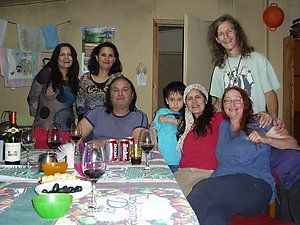 In Victoria we thought about going to a guesthouse, but had hard
time deciding whether to look for one in the city or cycle still a bit
forwards. Just as we thought about leaving from the tourist info, a
woman came to talk to us and invited us for a tea at her home. She was
Veronica, an English teacher who wanted to practise her English with
us. That suited us perfectly, we followed her to her house, had not
only tea but also something to eat and soon also a place to stay. Her
sisters and other members of the family came to meet us too so we had
both English and Spanish practise. We showed some photos of Finland
and Germany, had a bit of wine and spent a nice evening with our new
friends.
In Victoria we thought about going to a guesthouse, but had hard
time deciding whether to look for one in the city or cycle still a bit
forwards. Just as we thought about leaving from the tourist info, a
woman came to talk to us and invited us for a tea at her home. She was
Veronica, an English teacher who wanted to practise her English with
us. That suited us perfectly, we followed her to her house, had not
only tea but also something to eat and soon also a place to stay. Her
sisters and other members of the family came to meet us too so we had
both English and Spanish practise. We showed some photos of Finland
and Germany, had a bit of wine and spent a nice evening with our new
friends.
From Victoria we continued further east towards the mountains on a nice, relatively quiet paved road. We saw some amazing volcanic scenery in Malalcahuello National Reserve, and tomorrow we're heading to the Conguillio National Park, planning to cross it from north to south.
Back home in Germany we arranged through CouchSurfing that a small Czech family of three are living in our flat through winter and spring until we're coming back. They're taking care of our cat Germaine, so we can travel with a peaceful mind knowing that she's in good hands.
Wedding with a sauna
Posted: 2014-09-19 23:50:00, Categories: Travel, General, 509 words (permalink)
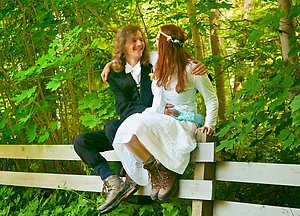 Sandra and I are married now. Our wedding took place at
a red wooden house by a lake with a sauna for relaxing after the main
party. We had beautiful weather, excellent food, great music, and
around 50 friends and relatives celebrating with us on our special
day.
Sandra and I are married now. Our wedding took place at
a red wooden house by a lake with a sauna for relaxing after the main
party. We had beautiful weather, excellent food, great music, and
around 50 friends and relatives celebrating with us on our special
day.
We wanted a leisurely atmosphere where nobody would feel being in a hurry. So we chose a location surrounded by nature and rented the place for the whole weekend. Preparations were done on Friday evening and guests were invited to come around midday on Saturday. There was no deadline at what time the party should end, and everybody who wanted could stay overnight until Sunday without any extra cost. Also our bed for the wedding night was prepared at the attic of the main house — we didn't see any reason to leave our own party and go to sleep in a hotel.
 The wedding ceremony was outside at the lakeshore, accompanied with
didgeridoo tunes which many guests found quite exciting. After the
formalities we received congratulations and raised a toast with
everybody, followed by a buffet style meal. My father gave a speech,
my brother sang and our friends entertained the guests by inviting
us in the traditional shoe game. Then four ex-colleagues of mine
from CSC took the stage with their guitars and drums: it was time
for the wedding waltz. After an hour of dancing, cake was served and
music turned towards rock. During the following two hours about half
of the guests said their goodbyes, heading back home. But the party
was still far from over.
The wedding ceremony was outside at the lakeshore, accompanied with
didgeridoo tunes which many guests found quite exciting. After the
formalities we received congratulations and raised a toast with
everybody, followed by a buffet style meal. My father gave a speech,
my brother sang and our friends entertained the guests by inviting
us in the traditional shoe game. Then four ex-colleagues of mine
from CSC took the stage with their guitars and drums: it was time
for the wedding waltz. After an hour of dancing, cake was served and
music turned towards rock. During the following two hours about half
of the guests said their goodbyes, heading back home. But the party
was still far from over.
 The sauna was hot starting from 8 pm. Sandra and I originally met
at a sauna evening in Helsinki so it was natural to have sauna in
our wedding too. The first hour was reserved for women, after that
all were welcome to join. The cook, the waiters and the band members
came as well. Fancy clothes were changed into towels,
people went swimming in the lake, came back for another round in the
sauna, chatted with each other on the terrace. After the sunset the
band brought their acoustic instruments and played for several hours
into the warm summer night: a perfect ending to the long day.
The sauna was hot starting from 8 pm. Sandra and I originally met
at a sauna evening in Helsinki so it was natural to have sauna in
our wedding too. The first hour was reserved for women, after that
all were welcome to join. The cook, the waiters and the band members
came as well. Fancy clothes were changed into towels,
people went swimming in the lake, came back for another round in the
sauna, chatted with each other on the terrace. After the sunset the
band brought their acoustic instruments and played for several hours
into the warm summer night: a perfect ending to the long day.
On Sunday morning we had breakfast together with everybody who had stayed overnight. There was still plenty of food left so all who wanted could take some and skip cooking for the next couple of days. With the help of guests we cleaned up the place and headed back home, exhausted but happy.
Our honeymoon trip will be to South America and Antarctica during the summer months of the Southern Hemisphere — which means during the winter in Europe. Details are still open, but because we like slow travel, the trip will certainly be longer than just one month. Before leaving, we'll spend the autumn at home in Southern Germany.
The photos on this page were taken by Panu Hällfors, all rights reserved. Please take a look at the larger selection on his home page.

Copyright Arto Teräs <ajt@iki.fi>, licensed under the Creative Commons Attribution-Share Alike 3.0 Unported License. (Unless otherwise mentioned in individual photos or other content.)